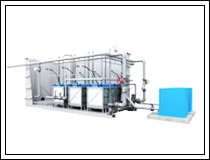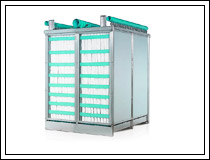Membrane Bio Reactor
A highly advanced and innovative technology applied in the field of biological treatment, the membrane bio reactor, commonly known as MBR, effectively combines a membrane process like microfiltration or ultrafiltration with a suspended growth bioreactor. Introduced during the 1960s, i.e., during the time when  commercial scale ultrafiltration (UF) and microfiltration (MF) membranes came into being, today the technology is extensively employed for municipal and industrial wastewater treatment. MBR can be used in treatment plants having a size of up to 80,000 population equivalent (48 MLD). commercial scale ultrafiltration (UF) and microfiltration (MF) membranes came into being, today the technology is extensively employed for municipal and industrial wastewater treatment. MBR can be used in treatment plants having a size of up to 80,000 population equivalent (48 MLD).
The Working Methodology
The MBR process can be easily utilized in activated sludge processes. Here, the membranes are used as liquid-solid separation for removing suspended solids/unwanted particles and producing good quality water. The process begins when pre-treated, screened influent enters the membrane bioreactor, where the process of biodegradation slowly begins. Now, the mixed liquor from the bioreactor is pumped along semi-crossflow filtration membrane modules. The treated effluent consists mainly of the permeate from the membranes of the bio reactor. Next, the entire stream of concentrated biosolids is rejected and returned to the bioreactor, and the excess biosolids are then exhausted either from the bioreactor or from the return line. As compared to conventional activated sludge systems, bio reactors are more suitable for waste water treatment as the separation of hydraulic and solid retention time provides a good control of biological reactions in the MBR system.
Factors Affecting MBR Technology
- Filtration in a membrane bio reactor or MBR primarily depends on the following few factors:
- Membrane Characteristics
- Pore Size
- Hydrophilicity
- Surface Roughness
- Surface Charge
- Sludge Characteristics
- Biomass Concentration
 Rheology (the flow of matter/sludge) Rheology (the flow of matter/sludge)- Particle Size
- Particle Structure
- SMP/ Colloids Concentration
- Operating Conditions (Biology)
- SRT/HRT (Solid Retention Time/Hydraulic Retention Time)
- Temperature
- Operating Conditions (Membrane)
- Deadend/CF
- TMP (Transmembrane Pressure)/Flux
- Aeration.
|